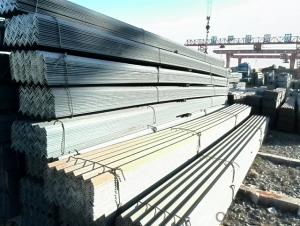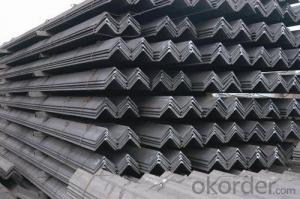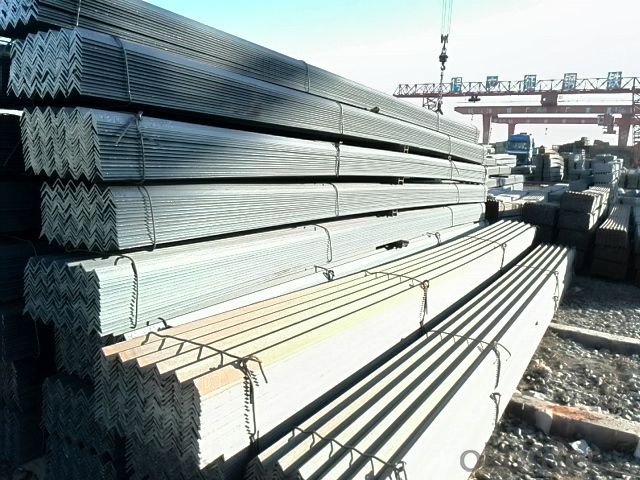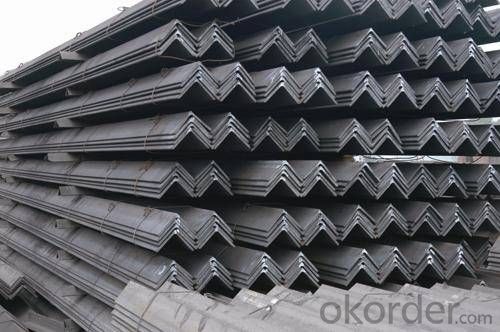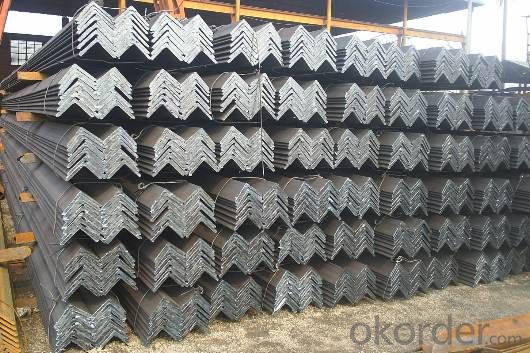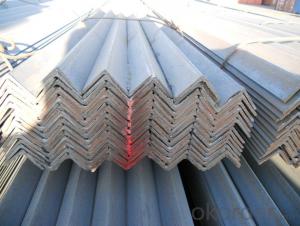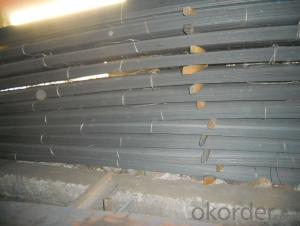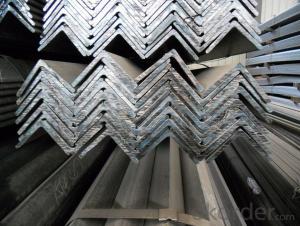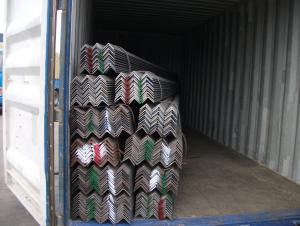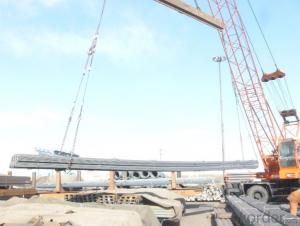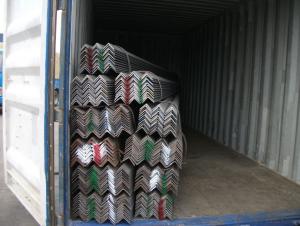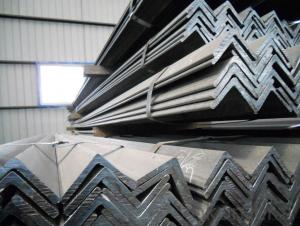Hot Rolled Equal Angle steel with high quality
- Loading Port:
- Tianjin
- Payment Terms:
- TT OR LC
- Min Order Qty:
- 25 m.t
- Supply Capability:
- 10000 m.t/month
OKorder Service Pledge
OKorder Financial Service
You Might Also Like
Specification
Okorder.com is a professional materials & equipment supplier & manufacturer, offers integrated one-stop services including real-time quoting and online cargo tracking. We are funded by CNBM Group, a Fortune 500 enterprise and the largest materials & equipment firm in China.
Product Applications:
According to the needs of different structures, Angle can compose to different force support component, and also can be the connections between components. It is widely used in various building structures and engineering structures such as roof beams, bridges, transmission towers, hoisting machinery and transport machinery, ships, industrial furnaces, reaction tower, container frame and warehouse etc.
Product Advantages:
OKorder's Steel Angles are durable, strong, and resist corrosion.
Main Product Features:
· Premium quality
· Prompt delivery & seaworthy packing (30-45 days after receiving deposit)
· Corrosion resistance
· Can be recycled and reused
· Mill test certification
· Professional Service
· Competitive pricing
Product Specifications:
1. Invoicing on theoretical weight or actual weight as customer request
2. Length: 6m, 9m, 12m as following table
3. Sizes

Sizes: 25mm-250mm | ||
a*t | ||
25*2.5-4.0 | 70*6.0-9.0 | 130*9.0-15 |
30*2.5-6.6 | 75*6.0-9.0 | 140*10-14 |
36*3.0-5.0 | 80*5.0-10 | 150*10-20 |
38*2.3-6.0 | 90*7.0-10 | 160*10-16 |
40*3.0-5.0 | 100*6.0-12 | 175*12-15 |
45*4.0-6.0 | 110*8.0-10 | 180*12-18 |
50*4.0-6.0 | 120*6.0-15 | 200*14-25 |
60*4.0-8.0 | 125*8.0-14 | 250*25 |
4.Material details:
Alloy No | Grade | Element (%) | |||||
C | Mn | S | P | Si | |||
Q235 | B | 0.12—0.20 | 0.3—0.7 | ≤0.045 | ≤0.045 | ≤0.3 | |
Alloy No | Grade | Yielding strength point( Mpa) | |||||
Thickness (mm) | |||||||
≤16 | >16--40 | >40--60 | >60--100 | ||||
≥ | |||||||
Q235 | B | 235 | 225 | 215 | 205 | ||
Alloy No | Grade | Tensile strength (Mpa) | Elongation after fracture (%) | ||||
Thickness (mm) | |||||||
≤16 | >16--40 | >40--60 | >60--100 | ||||
≥ | |||||||
Q235 | B | 375--500 | 26 | 25 | 24 | 23 | |
FAQ:
Q1: Why buy Materials & Equipment from OKorder.com?
A1: All products are carefully selected from China's most reliable manufacturing enterprises. Through its ISO certifications, OKorder.com adheres to the highest standards and a commitment to supply chain safety and customer satisfaction. We can guarantee the quality!
Q2: The products are invoicing on theoretical weight or on actual weight?
A2: We can do it in both manners, it’s according to buyer's requirement.
Q3: Can fit in the containers of 20fts for 6M long ?
A3: Yes, we can put them into the containers in the form sideling, in this way we can save the buyer much ocean freight.
Images:
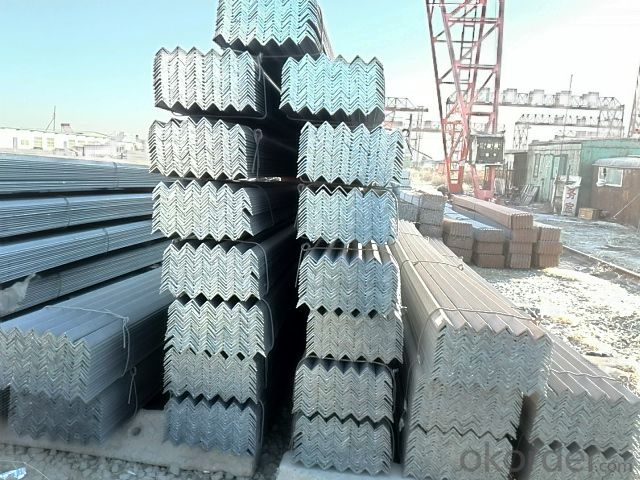
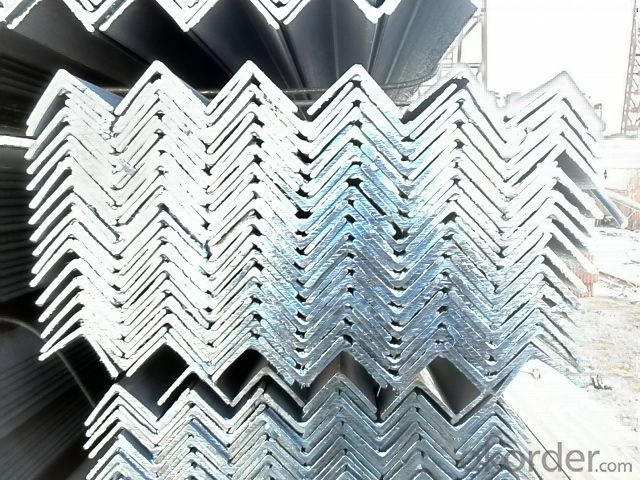
- Q: How do steel angles contribute to the sustainability of transportation systems?
- Several ways contribute to the sustainability of transportation systems through the utilization of steel angles. To begin with, steel angles find wide use in constructing infrastructure, such as bridges, highways, and railway tracks. These structures boast a longer lifespan and necessitate fewer repairs and replacements compared to alternative materials. As a result, maintenance costs and resource consumption are reduced. Furthermore, steel angles possess exceptional durability and resistance to severe weather conditions. This quality ensures the longevity and safety of transportation systems. Consequently, the need for frequent repairs or replacements is minimized, thereby decreasing the overall environmental impact and carbon emissions associated with transportation infrastructure. In addition, steel angles possess a high strength-to-weight ratio, enabling the design of lighter and more fuel-efficient vehicles. Utilizing steel angles in the manufacturing process of automobiles, trains, and ships leads to reduced vehicle weight, thereby enhancing fuel efficiency and decreasing greenhouse gas emissions during operation. Moreover, steel angles can be easily recycled at the end of their lifecycle. Globally, steel is one of the most recycled materials, boasting a recycling rate of over 85%. By recycling steel angles, not only is the demand for virgin steel production reduced, but energy is also saved, and greenhouse gas emissions associated with extraction and manufacturing processes are decreased. Overall, the incorporation of steel angles in transportation systems promotes sustainability by fostering durability, decreasing maintenance needs, improving fuel efficiency, and enabling efficient recycling. These factors collectively contribute to minimizing the environmental impact and enhancing the long-term viability of transportation infrastructure.
- Q: Are steel angles fire resistant?
- Yes, steel angles are generally considered to be fire resistant. Steel is an inherently non-combustible material and has a high melting point, making it able to withstand high temperatures during a fire. Steel angles, which are L-shaped structural members, are commonly used in construction and engineering applications due to their strength and durability. In fire conditions, steel angles can maintain their structural integrity and resist deformation, which is crucial for the safety of a building or structure. However, it is important to note that the fire resistance of steel angles can be affected by factors such as the size and thickness of the angles, the type of fire protection measures applied, and the duration and intensity of the fire. Fire protection measures like fire-resistant coatings, fire barriers, and fireproofing materials can be used to enhance the fire resistance of steel angles and improve the overall fire safety of a structure.
- Q: How are steel angles protected against chemical exposure?
- Steel angles can be protected against chemical exposure through various methods. One common method is the application of protective coatings. These coatings, such as epoxy or polyurethane coatings, act as a barrier between the steel angle and the chemicals it may come into contact with. The coatings are designed to be resistant to chemical attack and prevent corrosion or degradation of the steel. Another method of protecting steel angles against chemical exposure is by using stainless steel. Stainless steel contains a high level of chromium, which forms a protective oxide layer on the surface of the steel. This oxide layer acts as a barrier against chemical attack, preventing corrosion and degradation of the steel angle. In addition to coatings and stainless steel, steel angles can also be protected by using acid-resistant materials. These materials are specifically designed to resist the corrosive effects of chemicals and can be used to line tanks or containers that store or transport chemicals. By using acid-resistant materials, the steel angle is shielded from direct contact with the chemicals, reducing the risk of corrosion or damage. Regular maintenance and inspection are also crucial for protecting steel angles against chemical exposure. Inspecting the angles for any signs of damage or corrosion allows for early detection and intervention. Any damaged protective coatings can be repaired or replaced to ensure the continued protection of the steel angle. Overall, steel angles can be protected against chemical exposure through the application of protective coatings, the use of stainless steel, the use of acid-resistant materials, and regular maintenance and inspection. These measures help to prevent corrosion, degradation, and damage to the steel angle, ensuring its longevity and performance in chemical environments.
- Q: How do steel angles contribute to the overall load distribution in a structure?
- The contribution of steel angles to the overall load distribution in a structure cannot be underestimated. These L-shaped beams, also known as angle irons, play a vital role in construction projects. One of the key advantages of steel angles is their ability to offer stability and support to different parts of a structure. These angles are commonly used as braces, reinforcing the framework and preventing excessive movement or deformation. By evenly distributing the load across various sections of the structure, steel angles ensure the stability and integrity of the building. Furthermore, steel angles are frequently employed as connectors between different structural elements. They can be bolted or welded to beams, columns, or plates, acting as connectors that transfer loads from one component to another. This transfer of loads helps redistribute forces and minimize concentrated stress, thereby improving the load-bearing capacity and overall performance of the structure. Moreover, steel angles find use in the construction of platforms, stairs, and other support structures. By providing a secure and stable platform for people or equipment, they contribute to the overall load distribution by safely distributing the weight and forces applied to these structures. In summary, steel angles are indispensable in ensuring the overall load distribution in a structure. They provide stability, support, and connections between various structural components. The even distribution of weight and stress they enable helps prevent structural failures, ensuring the longevity and safety of the building.
- Q: What is the maximum length for a steel angle?
- The maximum length for a steel angle depends on various factors such as the manufacturing process, the size and thickness of the angle, and the capabilities of the steel supplier. In general, steel angles can range from a few inches to several feet in length. However, it is best to consult with a steel supplier or refer to industry standards to determine the specific maximum length for a particular steel angle.
- Q: What are the different surface finishes available for steel angles?
- There are several surface finishes available for steel angles, depending on the specific application and desired aesthetic. Some of the most common surface finishes for steel angles include: 1. Mill finish: This is the standard finish straight from the mill, with a smooth and clean surface. It is the most basic finish and is often used when appearance is not a significant factor. 2. Hot-dip galvanized: This finish involves immersing the steel angles in a bath of molten zinc, which creates a protective coating. It provides excellent corrosion resistance and is commonly used in outdoor or high-moisture environments. 3. Powder coated: In this process, a dry powder coating is applied electrostatically to the steel angles and then cured under heat. Powder coating offers a durable and attractive finish, with a wide range of colors and textures available. 4. Painted: Steel angles can also be painted with various types of paint, such as epoxy, enamel, or acrylic. Painting provides an additional layer of protection against corrosion and allows for customization in terms of color and appearance. 5. Stainless steel: Steel angles can be manufactured using stainless steel, which inherently provides a corrosion-resistant surface finish. Stainless steel angles are often used in applications where hygiene, durability, and aesthetic appeal are important, such as in food processing or architectural projects. 6. Shot blasting: This process involves propelling small steel shots at high velocity onto the surface of the angles. Shot blasting removes mill scale, rust, and other impurities, resulting in a clean, roughened surface that improves adhesion for subsequent coatings or paints. These are just a few examples of the different surface finishes available for steel angles. The choice of finish depends on factors such as the intended use, environmental conditions, desired appearance, and budget. It is important to consult with a steel supplier or manufacturer to determine the most suitable surface finish for a specific application.
- Q: Can steel angles be used as framing members in buildings?
- Yes, steel angles can be used as framing members in buildings. Steel angles are commonly used in construction as a structural element for framing, bracing, and supporting various components of a building. They offer excellent strength, durability, and load-bearing capacity, making them suitable for a wide range of applications in building construction. Steel angles can be used to create rigid frames, trusses, and connections, providing stability and support to the structure. Additionally, they can be easily welded, bolted, or connected using other fastening methods, allowing for flexible and efficient construction. Overall, steel angles are a versatile and reliable choice for framing members in buildings.
- Q: Can steel angles be used for framing windows or doors?
- Yes, steel angles can be used for framing windows or doors. They provide structural support and stability, making them a suitable choice for framing openings in buildings.
- Q: Are steel angles suitable for earthquake-prone areas?
- Steel angles are commonly used in construction, particularly in earthquake-prone areas, due to their excellent structural properties. The L-shaped design of steel angles provides significant stability and strength, making them suitable for withstanding seismic forces. Steel angles are known for their high tensile strength and ability to resist bending and twisting, which is crucial during an earthquake. Additionally, steel is a ductile material, meaning it can undergo significant deformation without undergoing failure, thus absorbing some of the energy generated by seismic activity. This flexibility helps to prevent catastrophic structural collapse during an earthquake. Furthermore, steel angles can be easily bolted or welded together, allowing for efficient and cost-effective construction. However, it is important to note that the design and construction of structures in earthquake-prone areas should be done in accordance with local building codes and regulations to ensure maximum safety.
- Q: What are the alternatives to steel angles in construction?
- Construction offers various alternatives to steel angles, each with its own advantages and disadvantages depending on the specific application. 1. Aluminum angles provide a lightweight and corrosion-resistant option for outdoor construction projects. They are easily machinable and have good electrical conductivity. However, they may not possess the same strength and load-bearing capacity as steel angles, limiting their suitability for heavy-duty structural applications. 2. Fiberglass angles, on the other hand, offer a lightweight and non-conductive solution that is highly resistant to corrosion and chemical damage. They are commonly used in industries exposed to harsh environments. However, their strength may be inferior to that of steel angles, necessitating additional reinforcement for heavy loads. 3. Carbon fiber angles are known for their lightweight and high-strength properties, making them ideal for weight reduction in critical applications like aerospace and automotive industries. However, they tend to be more expensive than steel angles and require specialized manufacturing techniques. 4. Wood angles, made from hardwood or engineered wood products, present a traditional and cost-effective alternative to steel angles. They are readily available and easy to work with, often used in residential and light commercial construction projects. However, their strength and durability may not match that of steel angles, and they may be prone to warping, cracking, or rotting over time. When selecting an alternative to steel angles, it is crucial to consider the specific requirements of the construction project, including load-bearing capacity, environmental conditions, and budget. Consulting with a structural engineer or construction professional can help determine the most suitable option for each scenario.
Send your message to us
Hot Rolled Equal Angle steel with high quality
- Loading Port:
- Tianjin
- Payment Terms:
- TT OR LC
- Min Order Qty:
- 25 m.t
- Supply Capability:
- 10000 m.t/month
OKorder Service Pledge
OKorder Financial Service
Similar products
Hot products
Hot Searches
Related keywords
